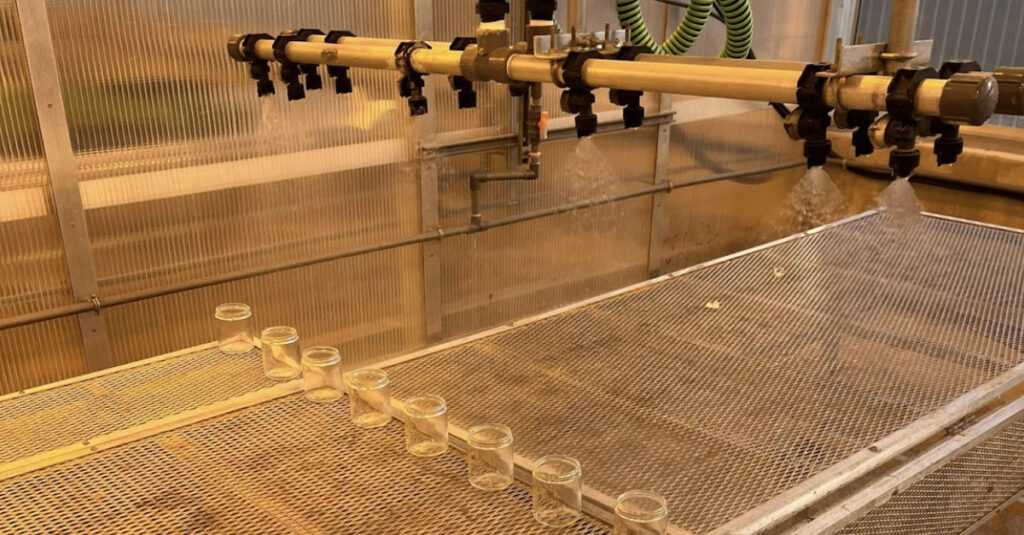In ScottsMiracle-Gro’s climate-controlled greenhouses, precise watering is crucial for plant health and our ability to deliver on product innovation initiatives for consumers. However, traditional overhead boom irrigation can be inefficient, leading to significant water waste. A recent study by Marysville R&D field station specialist Samuel Bott and research station manager Matthew Rawlings investigated alternative irrigation methods to conserve this vital resource.
“We wanted to look at the spray patterns of the irrigation booms and to figure out where we were lacking in certain areas and how much water we were using,” Bott said.
Boom irrigation inefficiencies
The study revealed that the overhead boom system delivered uneven water distribution. “Nozzles on the irrigation boom are not evenly placed, and that’s nice because you’re getting overlapping water patterns across most of the table,” Bott said. “But there are some places where it’s only getting one nozzle and others may be getting two or potentially three based on where it’s placed.”
Additionally, plant foliage often blocked water from reaching the soil, necessitating increased watering and further waste.“When that boom runs over them, maybe 50% of that water that goes over the plant is actually getting down to the soil surface, and the rest of it might just be bouncing off the plant or it just evaporates before it can get to the soil,” Bott said.
The boom system consumed an average of 96 gallons of water per pod daily, potentially totaling 500,000 gallons annually across 12 pods. “We found that 50-75% of the water was just going down the drain because of runoff and evaporation,” Bott stated.

Efficient alternatives: AquaMat and drip irrigation
To address these inefficiencies, researchers evaluated AquaMat and drip irrigation systems.
- AquaMat: This capillary mat system delivers water directly to plant roots from below, retaining 99% of the water. “To do an entire pod, it only takes 27 gallons compared to 96 in our conservative scenarios with the boom, so it’s about 70% less water usage,” Bott noted. “And the big thing is we don’t really lose a lot of water here. The AquaMat just holds it inside that mat, so very little runs out the end and very little is lost to evaporation. Whatever’s in that mat, the plants are using.”
- Drip Irrigation: This system utilizes precise emitters to deliver equal amounts of water to each plant. “If you have larger plants or larger pots in the same trial, you can just simply put two emitters in those larger pots,” Rawlings said. “Each emitter still runs for the same amount of time, but those larger pots with two emitters are actually getting twice the volume of water. So it’s actually a lot of flexibility in that way.” It averaged 33 gallons of water per pod.

Reduced water use and sanitation needs
Both AquaMat and drip irrigation significantly reduced water runoff, leading to decreased sanitation needs. Significant algae and dirt buildup on the floors of the greenhouses caused by boom irrigation can lead to issues with pests, disease, and slips, trips and falls.”Since we’ve put out the AquaMats and drip irrigation, some of these greenhouse pods are going from two to three cleanings per year to just one,” Bott said, minimizing water used in pressure washing, which can take up to two weeks to complete across all pods.
Implementation and impact
Following the study, ScottsMiracle-Gro has significantly increased its use of AquaMats, with enough now for four or five greenhouse pods. Several teams, such as those working in Marysville’s Controlled Environment Center for indoor cultivation and Pesticide Efficacy Research Laboratory, have also adopted drip irrigation.
“We’ve seen a nearly 50% reduction in overall water usage compared to the previous year,” Bott estimated. This shift toward efficient irrigation demonstrates a significant commitment to water conservation within ScottsMiracle-Gro’s research operations.
Water usage per day (per pod)
- Boom irrigation 96 gal
- AquaMat 27 gal
- Drip irrigation 33 gal

